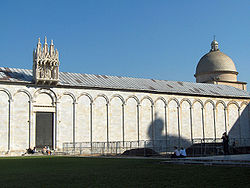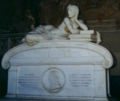- Camposanto Monumental
-
Camposanto Monumental
Archivo:Pisa camposanto interior.jpgInterior.
El Camposanto Monumentale ("Cementario monumental") es un edificio histórico en el lado norte de Plaza de los Milagros o Piazza del Duomo o Plaza de la catedral en Pisa, Italia."Campo Santo" recibe ese nombre pues se dice que fue construido alrededor un cargamento de tierra sagrada traído desde Tierra Santa (Jerusalén), del Gólgota, durante la Cuarta Cruzada por [Ubaldo de' Lanfranchi]], arzobispo de Pisa en el siglo XII. Una leyenda afirma que los cuerpos enterrados en dicho suelo se desonpondría en sólo 24 horas.
De este lugar se deriva el uso de " camposanto" como sinómino de "cementerio" en los países católicos.
La zona de enterramientos se encuentra sobre las ruinas del antiguo baptisterio de la iglesia de Santa Reparata, que en su día ocupaban los terrenos donde hoy se asienta acuila catedral.
El solar está delimitado por una larga hilera de arquerías ciegas románicas que forman el muro meridional interrumpido por numerosas puertas.
El adjetivo "monumental" lo diferencia del cementerio actuamente en uso en Pisa que se creo con posterioridad. También se le llama camposanto vecchio ("cementerio viejo").
Contiene 600 lápidas muchas de ellas grecorromanas. Los muros de las galerías están cubiertos por unos admirables frescos realizados en la 2da mitad del siglo XIV y a lo largo del siglo siguiente por artistas como Venoso Gozzoli, Tadeo Gaddi, Andrea di Buonaiuto y Antonio Veneziano.
Contenido
Historia
Esta construcción fue la cuarta y última que se erigió en la Piazza del Duomo. Data de un siglo tras la llegada de la tierra del Gólgota.
La construcción de este enorme, oblongo Gothic cloister was begun in 1278 by the architect Giovanni di Simone. He died in 1284 when Pisa suffered a defeat in the naval battle of Meloria against the Genoans. The cemetery was only completed in 1464.
It seems that the building was not meant to be a real cemetery, but a church called Santissima Trinità (Most Holy Trinity), but the project changed during the construction. However we know that the original part was the western one (and this should be, at least for a while, the mentioned church), and all the eastern part was the last to be made and closing the structure.
Construcción
The outer wall is composed of 43 blind arches. There are two doorways. The one on the right is crowned by a gracious Gothic tabernacle. It contains the Virgin Mary with Child, surrounded by four saints. It is the work from the second half of the 14th century by a follower of Giovanni Pisano. This was the original entrance door. Most of the tombs are under the arcades, although a few are on the central lawn. The inner court is surrounded by elaborate round arches with slender mullions and plurilobed tracery.
The cemetery has three chapels. The oldest ones are the chapel Ammannati (1360) and takes its name from the tomb of Ligo Ammannati, a teacher in the University of Pisa; and the chapel Aulla, were there is an altar made by Giovanni della Robbia in 1518. In this chapel we can see also the original lamp that Galileo Galilei saw, in his time, inside the cathedral and that was shortly replaced by the bigger one we can see now. The last chapel was Dal Pozzo, commissioned by archbishop of Pisa Carlo Antonio Dal Pozzo in 1594; it has an altar dedicated to St. Jerome and a little dome.
Sarcófagos
The Campo Santo contained a huge collection of Roman sarcophagi, but there are only 84 left together with a collection of Roman and Etruscan sculptures and urns, now in the Museum of the vestry board.
The sarcophagi were initially all around the cathedral, often attached to the building itself. That until the cemetery was built, then they were collected in the middle all over the meadow. Carlo Lasinio, in the years he was the curator of the Campo Santo, collected many other ancient relics that were spread in Pisa to make a sort of archeological museum inside the cemetery. Nowadays the sarcophagi are inside the galleries, near the walls.
Frescos
The walls were once covered in frescoes; the first were applied in 1360, the last about three centuries later. The first was the Crucifixion by Francesco Traini, in the south western side. Then, continuing to right, in the southern side, the Last Judgement, The Hell, The Triumph of Death and the Anacoreti nella Tebaide, usually attributed to Buonamico Buffalmacco. The cycle of frescoes continues with the Stories of the Old Testament by Benozzo Gozzoli (15th century) that were situated in the north gallery, while in the south arcade were the Stories of Pisan Saints, by Andrea Bonaiuti, Antonio Veneziano and Spinello Aretino (between 1377 and 1391), and the Stories of Job, by Taddeo Gaddi (end of 14th century). In the same time, in the north gallery were the Stories of the Genesis by Piero di Puccio.
On 27 July 1944, a bomb fragment from an Allied raid started a fire. Due to all the water tanks being controlled, the fire could not be put out in time, and it burnt the wooden rafters and melted the lead of the roof. The destruction of the roof severely damaged everything inside the cemetery, destroying most of the sculptures and sarcophagi and compromising all the frescoes.
After World War II, restoration work began. The roof was restored as closely as possible to its pre-war appearance and the frescoes were separated from the walls to be restored and displayed elsewhere. Once the frescoes had been removed, the preliminary drawings, called sinopie were also removed. These under-drawings were separated using the same technique used on the frescoes and now they are in the Museum of the Sinopie, on the opposite side of the Square. Commons
 Wikimedia Commons alberga contenido multimedia sobre Camposanto Monumental.
Wikimedia Commons alberga contenido multimedia sobre Camposanto Monumental.
The restored frescoes that still exist are gradually being transferred to their original locations in the cemetery, inside the cemetery, to restore the Campo Santo's pre-war appearance.
Galería de imágenes
Fresco de Benozzo Gozzoli.
Sarcofago beatrice.jpgSarcófago di Beatrice di Toscana
Fuentes
- Tobino, Mario (1982). Pisa la Piazza dei Miracoli. De Agostini.
coordenadas =
Categoría: Cementerios de Italia
Wikimedia foundation. 2010.









